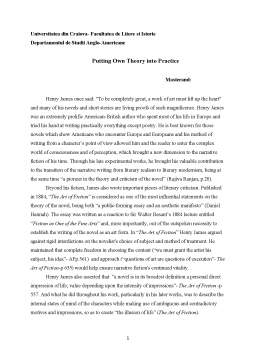Extras din referat
Henry James once said: "To be completely great, a work of art must lift up the heart" and many of his novels and short stories are living proofs of such magnificence. Henry James was an extremely prolific American-British author who spent most of his life in Europe and tried his hand at writing practically everything except poetry. He is best known for those novels which show Americans who encounter Europe and Europeans and his method of writing from a character’s point of view allowed him and the reader to enter the complex world of consciousness and of perception, which brought a new dimension to the narrative fiction of his time. Through his late experimental works, he brought his valuable contribution to the transition of the narrative writing from literary realism to literary modernism, being at the same time “a pioneer in the theory and criticism of the novel” (Rajiva Ranjan, p.20).
Beyond his fiction, James also wrote important pieces of literary criticism. Published in 1884, “The Art of Fiction” is considered as one of the most influential statements on the theory of the novel, being both “a public-forming essay and an aesthetic manifesto” (Daniel Hannah). The essay was written as a reaction to Sir Walter Besant’s 1884 lecture entitled “Fiction as One of the Fine Arts” and, more importantly, out of the outspoken necessity to establish the writing of the novel as an art form. In “The Art of Fiction” Henry James argued against rigid interdictions on the novelist's choice of subject and method of treatment. He maintained that complete freedom in choosing the content (“we must grant the artist his subject, his idea”- AFp.561) and approach (“questions of art are questions of execution”- The Art of Fiction-p 655) would help ensure narrative fiction's continued vitality.
Henry James also asserted that ”a novel is in its broadest definition a personal direct impression of life; value depending upon the intensity of impressions”- The Art of Fiction -p 557. And what he did throughout his work, particularly in his later works, was to describe the internal states of mind of the characters while making use of ambiguous and contradictory motives and impressions, so as to create “the illusion of life” (The Art of Fiction).
His earlier work belongs to Realism because he was extremely careful in describing details of his characters' physical surroundings. But throughout his long career James maintained a strong interest in a variety of artistic movements. His work gradually became more symbolic and more difficult to read as he entered more deeply into the minds of his characters. Due to the intense preoccupation with the consciousness of his major characters, James's later work foreshadows the extensive developments in 20th century fiction.
In “The Art of Fiction” James particularly insisted that writers be allowed the greatest freedom possible in presenting their view of the world. “We must grant the artist his subject, his idea, his donnée; our criticism is applied only to what he makes of it” (The Art of Fiction -page 561). He also maintained that faithfulness to life, that is realism, is the most important factor , while the expertise of the writer, just as in the case of the painter, depends on hiss sensibility and openness to impressions: ‘’Experience is never limited and it is never complete; it is an immense sensibility, a kind of huge spiderweb of the finest silkthreads suspended in the chamber of consciousness”(The Art of Fiction - page 559) . And what James did in his fiction was to speak from his own personal experience -for much of his life James was an outsider living in Europe- juxtaposing characters from different worlds—the Old World , simultaneously artistic, alluring but also corrupting; and the New World, where people are often open and assertive, but also brash and unpolished—and explore how this clash of personalities and cultures affects the two worlds. And the result was magnificent, in his long writing career managing to write 22 novels, including two left unfinished at his death, and 112 tales of varying lengths, along with many plays and a large number of nonfiction essays and books.
He knew from first-hand experience how it was to be an American in Europe and this subject matter came through as a recurring theme in his books, which contrasted American innocence (or a lack of sophistication) with European sophistication (or decadence), see for example The Portrait of a Lady, The Ambassadors and The Golden Bowl.
According to the ideas expressed by Henry James in “The Art of Fiction”, the only criterion that could be applied in judging the value of the novel is its artistry, not morality or choice of the subject matter: “nothing, of course, will ever take place of the good old fashion of liking a work or not liking it”, so any selection of James's novels as "major" depends to some extent on personal preference, but the following books have achieved prominence among his works in the views of many critics.
Bibliografie
Daniel Hannah- Henry James, Impressionism and the Public”- 1st edition Routledge Publishing House 2013
Henry James- The Art of Fiction - Published in Longman's Magazine 4 (September 1884), and reprinted in Partial Portraits (Macmillan, 1888); paragraphing and capitalization follow the Library of America edition. Available at https://public.wsu.edu/~campbelld/amlit/artfiction.html
Henry James Books- Biography and List of Works- available at https://www.biblio.com/henry-james/author/599
Nasrullah Mambrol- The Realism of Henry James in Literary Theory and Criticism, January 8th, 2018- https://literariness.org/2018/01/08/the-realism-of-henry-james/
Rajiva Ranjan- A Critical Analysis on Art of Fiction by Henry James in International Journal of English Language, Literature and Translation Studies, Vol. 3, Issue 4, 2016, available at http://www.ijelr.in/3.4.16/20-25%20Dr.%20RAJIVA%20RANJAN.pdf
Preview document
Conținut arhivă zip
- Putting Theory into Practice.docx
















